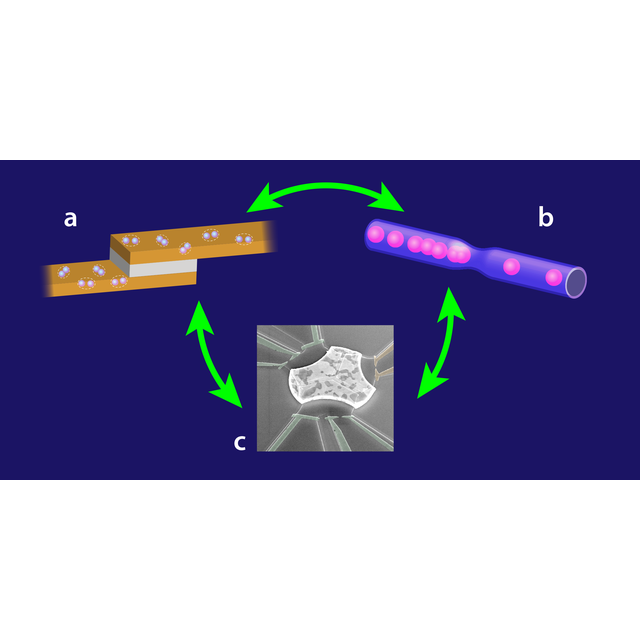Researchers have implemented an electronic circuit that can simulate the many-body physics expected to take place in one-dimensional (1D) quantum systems, constituted of either bosonic or fermionic particles with repulsive interactions. The presence of a single impurity induces in 1D conductors a transition toward an insulating state, revealing of the underlying correlations. By simulating this transition, the researchers were able to test previously inaccessible aspects of fundamental theory for 1D quantum systems.
Strong many-body correlations give rise to intriguing states of matter and unconventional behaviors of immense potential. Quantum phase transitions at zero temperature are believed to underpin many such phenomena, yet the complexity of real-world strongly-correlated materials and the theoretical challenge posed even by simplified models impedes a microscopic understanding. The realization of simple, well-characterized systems for studying the strongly-correlated and quantum critical physics is therefore highly desirable. In one-dimensional systems, the enhanced interactions give rise to paradigmatic phases of strongly-correlated matter described by the ‘Tomonaga-Luttinger liquid’ concept. However, the metal-insulator quantum phase transition induced by even a single impurity impedes experimental exploration. Furthermore, this hallmark signature still eludes a full theoretical treatment.
A team of researchers from the Centre de Nanosciences et de Nanotechnologies - C2N (CNRS/Université Paris-Sud – Université Paris Diderot) and the laboratory Matériaux et Phénomènes Quantiques – MPQ (CNRS/Université Paris Diderot) have deeply investigated the collective physics at one dimension and the resulting metal-insulator quantum phase transition by means of quantum simulation with a nano-engineered circuit. Their work was published in Physical Review X, and was featured by a ViewPoint* published on the American Physical Society website “Physics”.
Their measurements reveal the universal scaling flows to an insulating state, establish a quantitative relation with the circuit parameters, and explore the out-of-equilibrium regime. With the quantum simulator benchmarked by the precise agreement with untested and novel predictions, they then achieved quantum simulation in its strongest sense by elucidating theoretically unsolved regimes. Quantum simulation can provide a powerful workaround, as shown with this quantum circuit implementing a Tomonaga-Luttinger liquid analog with adjustable electronic interactions and a fully tunable scattering impurity.
Their approach opens the path to in-depth investigations of various facets of correlated physics, and sheds a new light on the modified transport properties of quantum components when embedded into a circuit. It also constitutes a landmark toward quantum simulation in the strongest sense, by elucidating interaction regimes which resist theoretical solutions.
* Viewpoint: Circuit Simulates One-Dimensional Quantum System, Emanuele Dalla Torre and Eran Sela (September 19, 2018) - Physics 11, 94
Reference:
Circuit Quantum Simulation of a Tomonaga-Luttinger Liquid with an Impurity,
A. Anthore, Z. Iftikhar, E. Boulat, F. D. Parmentier, A. Cavanna, A. Ouerghi, U. Gennser and F. Pierre
Physical Review X 8, 031075 (September 2018)
DOI: https://doi.org/10.1103/PhysRevX.8.031075
- Centre de Nanosciences et de Nanotechnologies – C2N (CNRS/Université Paris-Sud/ Université Paris Diderot)
- Laboratoire Matériaux et Phénomènes Quantiques – MPQ (CNRS/Université Paris Diderot)
Contacts:
- Frédéric Pierre, CNRS senior researcher at C2N
- Anne Anthore, Associate Professor from University Paris Diderot at C2N
Figure : Three physical systems can exhibit the same insulator-to-metal quantum phase transition thought to occur in a 1D system of quantum particles, known as a Tomonaga-Luttinger liquid (TLL). The systems are: Two superconductors separated by a thin resistive layer (top left); a 1D array of electrons in the presence of an impurity (top right); and a micrometer-sized electronic device made of nanochannels connected to a central quantum dot (bottom). Here, researchers have used the latter as a quantum simulator, which allows them to investigate features of the TLL phase transition that can't be studied in the other two systems. (APS/Alan Stonebraker)









